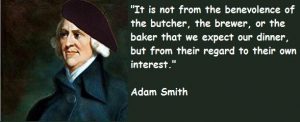Some writers have incorrectly translated this French phrase as Let Sleeping Dogs Lie, and attributed it (among others) to Prime Minister Walpole. But this doctrine means much more: it maintains that free trade is preferable to ‘protected’ trade, and that the state should not, without reason, interfere in economic affairs. It is a great pity that it is merely an eighteenth century doctrine, hardly thought of today. Adam Smith published Wealth of Nations in 1776, that constitutional date for the United States; Smith wrote that tariffs prevented or slowed down world trade, and therefore good living standards in all countries. Free trade, he insisted, provided competition and thus made certain cheaper goods of high quality. This equation would benefit both consumers and manufacturers, the latter becoming more efficient. Workers would be trained to do fewer jobs, to better effect. This could only happen, Smith claimed, in a free market.
The doctrine of Laissez-faire was crucial politically, as it influenced the new Poor Law (1834), as well as the budgets of Sir Robert Peel and William E. Gladstone (reducing duty on most imported goods) as well as the much awaited repeal of the Corn Laws in 1846.
The state was therefore left to pay for and provide services which private enterprise would find unprofitable: defence (army, navy, administration and logistics), protection of life and property, education and public health. Not many people in the 18th century could calculate how much these services, taken for granted in modern times, would eventually cost.
The doctrine was bound to fail because Smith had not correctly calculated what the people would make of it: ‘it is created for the defence of the rich against the poor, or of those who have some property against those who have nothing’. At first Britain was able to promote free trade because she was extremely rich and had an empire; throughout the nineteenth century she remained the only country firmly committed to free trade. Her example was not followed: in Europe most important states abandoned Laissez-faire in favour of ‘protective’ tariffs starting in the 1870s. Austria-Hungary (1874), Russia (1877), Germany (1879), Italy (1887) and France in 1892. The USA made her move in 1890.
In Britain, where it had all started, J. Chamberlain tried to introduce protection with his tariff reform campaign in 1903, but Britain did not actually abandon free trade until 1932, while the Great Depression (q.v.) was raging. One of the basic tenets found in the formation of the EEC was that of a freed European market, and free movement of workers in the member states. This has only achieved partial success, due to traditional zenophobia and the customary mal-administration.










Leave A Comment